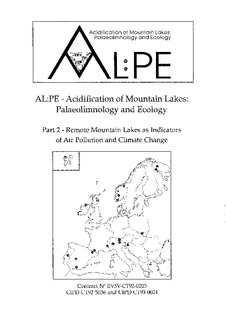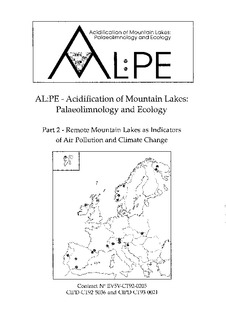| dc.contributor.author | Wathne, B. | nb_NO |
| dc.contributor.author | Patrick, S. | nb_NO |
| dc.contributor.author | Cameron, N. | nb_NO |
| dc.contributor.other | Wathne, B. - Project manager | nb_NO |
| dc.coverage.spatial | Europa | nb_NO |
| dc.date.accessioned | 2014-08-01T10:40:47Z | |
| dc.date.available | 2014-08-01T10:40:47Z | |
| dc.date.issued | 1997 | nb_NO |
| dc.identifier | 3638 | nb_NO |
| dc.identifier.isbn | 82-577-3198-6 | nb_NO |
| dc.identifier.issn | 1894-7948 | nb_NO |
| dc.identifier.uri | http://hdl.handle.net/11250/209324 | |
| dc.description.abstract | AL:PE, funded by the European Commission is a multi-disciplinary, multi-national project coordinated by research groups in London and Oslo. It represents the first comprehensive study of remote mountain lakes at a European scale. The AL:PE project is concerned with remote mountain lake ecosystems throughout the artic and alpine regions of Europe that, dispite their remoteness are threatened by acid deposition, toxic air pollutants and by climate change. Whilst the study is directly concerned primarily with the lakes themselves, the results of the study have much greater sigificance as these lake ecosystems, togheter with their sediment records, act as environmental sensors for the wider artic and alpine environments. The AL:PE results illustrate two over-arching issues: (i) the importance of these remote and sensitive ecosystems as sensors of long-range transported pollutants and as providers of early warning signals for more widespread environmental change and (ii) the importance and urgency of understanding the present and future impacts of pollutants, both singly and in combination, on aquatic ecosystems. Although acid deposition is currently thought to be the most potent threat, disentangling the interactions between the effects of changing deposition patterns of acids, nutrients, trace metals and trace organic in the context of global warming presents an immense scientific challenge. The AL:PE programme has begun to address this challenge and its successor EU project, MOLAR, is designed to tackle the issues more specifically by focussing on in-depth studies of key sites. | nb_NO |
| dc.description.sponsorship | Commission of the European Communities The Research Council of Norway - TVLF The Austrian Research Foundation | nb_NO |
| dc.publisher | Norsk institutt for vannforskning | nb_NO |
| dc.relation.ispartofseries | NIVA-rapport;3638 | nb_NO |
| dc.rights | Navngivelse-IkkeKommersiell-DelPåSammeVilkår 3.0 Norge | nb_NO |
| dc.rights.uri | http://creativecommons.org/licenses/by-nc-sa/3.0/no/ | nb_NO |
| dc.subject | sur nedbør | nb_NO |
| dc.title | AL:PE - Acidification of mountain lakes: Palaeolimnology and ecology. Part 2 - Remote mountain lakes as indicators of air pollution and climate change | nb_NO |
| dc.type | Research report | nb_NO |
| dc.rights.holder | Norsk institutt for vannforskning/Norwegian institute for water research | nb_NO |
| dc.subject.nsi | VDP::Matematikk og naturvitenskap: 400 | nb_NO |
| dc.source.pagenumber | 525 | nb_NO |
| dc.subject.keyword | høyfjell | nb_NO |
| dc.subject.keyword | innsjø | nb_NO |
| dc.subject.keyword | vannkjemi | nb_NO |
| dc.subject.keyword | biologi | nb_NO |
| dc.subject.keyword | europeisk samarbeid | nb_NO |
| dc.subject.keyword | water chemistry | nb_NO |
| dc.subject.keyword | high | nb_NO |
| dc.subject.keyword | mountain | nb_NO |
| dc.subject.keyword | lakes | nb_NO |
| dc.subject.keyword | biology | nb_NO |
| dc.subject.keyword | european | nb_NO |
| dc.subject.keyword | co-operation | nb_NO |
| dc.relation.project | O-91048 | nb_NO |


